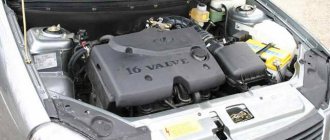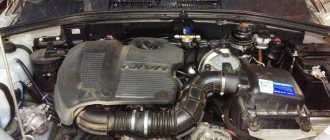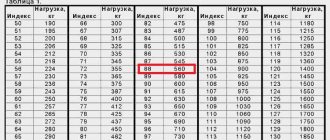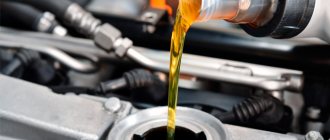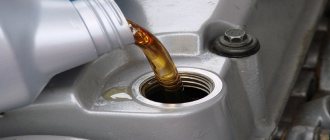The other day, on the eve of a trip to the sea, I changed the engine oil. I change the oil approximately every 10,000 km. I do everything myself, because... there is nothing complicated there. And besides, it seems to me that if you change the oil somewhere at a service center, they won’t completely drain it anyway, because... they need to do work faster in order to get more done and, accordingly, earn more (as they say, nothing extra - just business). For consumables I use:
1. Oil filter MANN (article W753), or MAHLE (article OC467). I use these manufacturers because... their valve always works correctly (if it’s not a fake, of course). The operation of the valve means that when you start the car when it is cold, the oil pressure lamp goes out almost instantly after starting the internal combustion engine (unfortunately, this does not happen with all oil filter manufacturers). This means that after parking the car with the engine turned off, the oil from the filter does not flow into the sump and, upon startup, is immediately supplied to the oil system, thereby minimizing wear. But the main wear and tear of a serviceable internal combustion engine occurs precisely during a cold start! This time I used MANN.
2. O-ring for the Sasic pan plug (part number 1640540). I use Sasic because on many French cars (including here) it comes from the factory in the original. The ring must be changed every time the oil is changed.
3. Sasic pan plug (article 1630210). I always change the cork purely out of convenience and laziness to wash my hands again. When unscrewing the old plug, I don’t try to fish it out from under the stream of old hot oil - it just falls into the drain container for the old oil. At the same time, your hands remain clean and without burns, because... Do not douse yourself with old hot oil. The price for such convenience is only 25 rubles. Acceptable for me))))
About the Lada Largus model and its engine
Largus belongs to the small class station wagons, built on the B0 platform. This is the same Dacia Logan MCV, only completely adapted to the realities of Russian roads and operating conditions. It has been successfully produced by Tolyatti residents for 7 years and does not lose popularity among consumers.
Largus is available in three variations: 5- and 7-seater station wagons, as well as a van designed for two people, including the driver.
All three modifications can be equipped with two powertrain options:
8 “boiler”, 1.6 l and 87 hp. (K7M) - developed by AvtoVAZ specialists;
16-valve, 1.6 l, 102 “horses” (K4M) – developed by Renault-Nissan specialists.
Liquids used (type, volume, brand)
See also Maintenance Schedule
The table shows the fluids, lubricants and fuel used on the Lada Largus car.
| Refueling or lubrication point | Quantity | Name of material |
| Fuel (fuel tank) | 50 l | On Renault engines - motor gasoline not lower than AI-95 |
| On VAZ engines - motor gasoline not lower than AI-92 | ||
| Gas cylinder (cars with LPG) | 90 l (22 m3) | Compressed natural gas (methane) |
| Engine cooling system (radiator), including interior heating system (coolant) | Renault - 6 l. VAZ - 7 l. | antifreeze GLACEOL RX (type D) (standard Renault), CoolStream NRC (standard AVTOVAZ), or analogues |
| Engine lubrication system (including filter) | K7M - 3.3 l K4M - 4.8 l | Motor oils with API quality class: SL; SM and SAE viscosity level: 5W30; 5W40; 5W50; 0W30; 0W40 (standard oil from AVTOVAZ: for Renault engines - “Shell PC 1021” for VAZ engines - “Rosneft MAGNUM MAXTEC 5W-40”) |
| 11189 - 4.1 l 11182 - 4.2 l 21129 - 4.2 l | ||
| Gearbox oil | JH3 - 2.8 l JR5 - 2.5 l 21809 - 2.25 l | Transmission oils: API quality class: GL-4; GL-5 and viscosity level SAE: 75W80 (standard oil from AVTOVAZ: for manual transmission Renault - “ELF TPM 4501”, for manual transmission VAZ - “Rosneft KINETIC MT 75W-85”) |
| Hydraulic brake drive (brake fluid) | 0.5 l | Brake fluid type DOT-4, (standard from AVTOVAZ - “Shell DF40+” or “ELF 650”) |
| Front wheel drive joints (lubricant for CV joints) | — | MOBIL CVJ 825 BLACK STAR or MOBIL EXF57C grease |
| Power steering | about 1 l. | Power steering fluid (oil) Mobil ATF 52475 (standard), or ELFMATIC G3 |
| Gearbox control mechanism | — | MOLYKOTE 33 “MEDIUM” lubricant |
| Air conditioning refrigerant | 475 ± 35 g | Freon R134a (standard from AVTOVAZ - “Arkema”) |
| Air Conditioning Compressor Oil | 135 ± 10 g. | Sanden SP-10 |
| Air conditioning system | 470 g | Refrigerant (freon) R134a |
| Windshield washer reservoir | 4.7 l. | Windshield washer fluid, water |
same in the picture (main liquids used)
Remember that your car uses different types of fluids, and a puddle under your car doesn't always indicate a problem—sometimes it's just condensation from the air conditioner running on a hot day. Therefore, you shouldn’t panic right away, it’s better to take a closer look. Coolant leaks usually appear as green, orange, or pink liquid stains that have a sweet smell. Transmission fluid and power steering fluid are pink or red in color. Motor oil is golden brown to black. Brake fluid is clear, yellow to dark brown in color.
What to look for when choosing
Before pouring oil into the Lada Largus, you need to remember that no matter what lubricant is used, there is no fundamental difference in the number of valves - it “works” equally well on both engine options.
Therefore, first of all, it is necessary to decide on the composition. This definition depends on the operating mode of Largus. If the car will be used daily, then it is worth pouring into such a car oil created on the basis of conventional or hard hydrocracking.
In simple terms, we are talking about synthetic lubricant and semi-synthetic lubricant, respectively. You can also use mineral oil, but you will have to change it more often.
If Lada Largus is driven at high speeds, then it is necessary to use lubricants based on esters or PAO. As for mineral oils, they are completely unsuitable for such operating modes.
Regulations for changing engine oil in Lada Largus
Engine oil has its own shelf life and performance properties. It is believed that motor oil should remain inside the engine for no more than 1 year. After this, it becomes unsuitable for further use.
Another factor influencing the condition of the lubricant is mileage. After 15,000 km. the oil picks up a large amount of dirt and deposits, and the additive package will lose its properties and begin to harm the engine.
Thus, the maintenance schedule for Lada Largus is once every 15,000 km. mileage or once a year.
In fact, technical fluid should be replaced more often than once every 10 thousand kilometers. If there is constantly fresh oil in the crankcase, the engine life will increase. In addition, performing this procedure frequently will reduce the likelihood of carbon deposits forming on the pistons and, as a result, will eliminate increased oil consumption in the future.
Tips from Largus owners
Thanks to its unpretentiousness, Lada Largus is able to “work” on any of the oils on the market.
In order for the engine to operate as long as possible, it is necessary to change the lubricant a little more often than indicated in the regulatory documentation - approximately every 8 thousand kilometers. This will allow the lubricant to protect engine parts from excessive wear.
And the market is now simply teeming with proposals, both from well-known brands and from “Chinese” analogues. The main condition is not to fall for a fake, as it can have a detrimental effect on the engine.
In order not to buy a “pig in a poke”, you need to purchase lubricants for Largus only from trusted sellers and avoid cheap offers. If you follow these recommendations, the “goose” motor (as Largus is popularly called) will last a long time.
Why can the oil level in a Largus engine change?
Sooner or later, every car owner may face the problem of decreasing engine oil level. There are several reasons for this phenomenon:
- natural oil consumption;
- reducing its quantity due to leaks.
In the first case, the problem may appear after 150 thousand kilometers on Lada engines. As the piston rings and valve stem seals wear out, lubricant enters the cylinders and begins to burn along with the fuel. In this case, appropriate engine repairs with replacement of faulty elements will help.
Leaks appear due to wear of the oil seals of the moving parts - typical for all four engines. But VAZ engines are also characterized by gasket leaks, which are absent in Renault.
How to replace the oil filter
You will need: a 10" or 13" wrench, a puller or a screwdriver.
On the K4M engine, access to the oil filter is blocked by the engine protection, which will have to be removed (6 x 10 screws). Or remove the fuel frame protection from above by unscrewing the 2 “13” screws. Place an empty container under the filter and turn it counterclockwise using a puller.
If you don’t have a special tool, you can use a screwdriver. For easier access to the filter on the K7M engine, you can remove the exhaust manifold thermal shield by unscrewing the three mounting screws. Then pierce the filter housing with a screwdriver (closer to the bottom of the filter, so as not to damage the motor fitting), unscrew the filter, using the screwdriver as a lever.
Fill the new filter 1/3 full with new engine oil and lubricate the sealing ring with it. Then install the oil filter, tightening it by hand until the O-ring comes into contact with the cylinder block. After this, tighten the oil filter another 3/4 turn.
The choice of motorists themselves
The reader has probably already found out what kind of oil to pour into the Lada Largus engine. 6 different options were named. There are other, “less common” substitutions:
- Lukoil Lux Synthetic SN, 5W40;
- SHELL Helix Ultra, 5W40 (many fakes);
- ELF EVOLUTION 900 FT, 0W30;
- TEXACO Havoline Energy, 5W30;
- Nissan Oil, 5W40 (factory option for the Almera sedan);
- GM Dexos 2, 5W30.
By the way, the new name for EVOLUTIONSXR is EVOLUTION 900SXR! You don't look for something that doesn't exist.
ELF EVOLUTION 900 SXR packaging
The question remains, what is the volume of the engine crankcase? Answer:
- The crankcase is designed for 5 liters. oils;
- Filling volume if the filter is not changed – 4.6 liters;
- When changing with a filter, add another 200-250 ml.
Now the reader understands how much oil to pour into the Lada Largus engine, whose 16 valves require as much as 5 liters. lubricants! The filling volume will be less than 5. Read more about the engine models on the Lada Largus in the article: what engines are installed on the Lada Largus.
How I poured liquid moth 5W40 into a VAZ Largus Cross
As practice has shown, in the VW Polo engine, liquid moth oil with molybdenum has proven itself to be the best.
The car itself has traveled about 300,000 km. and the engine itself was in perfect condition. Therefore, on a loaded Largus, it was decided to fill in VAZ oil from Liqui Moly Optimal 5w40.
The vehicle is constantly loaded with up to half a ton of cargo, and travels about 500 km/day. Under such loads, you need the best grade with a good mineral base, so that there is no scuffing, soot, or sagging of the rings. As you know, VAZ engines suffer from oil burns, which means a lot of wear on parts.
Therefore, such cars are often sold with mileages of 100,000 km or more. Frequent problems are carbon deposits in the intake system, we try with spark plugs and coils, which causes the car to lose power. And also scuffing in the cylinders, which leads to a problem with the piston system.
Rosneft is poured from the plant, and here it is important to understand how you will operate your car.
If these are ordinary trips around the city or to the country, then this oil is enough. But if this truck will be driven with loads higher than the recommended curb weight, as well as many kilometers per day, then high technologies in the field of liquids are needed.
Here we need additive packages that provide wear protection, wash parts, and quickly wash out slag and carbon from the cylinders and pistons. DO NOT allow valves to become clogged. Additives must work for a long time, every day removing deposits and slag deposits from engine parts.
Types of oils
- Synthetic is a high-quality oil with continuous advantages. This is a very fluid and liquid composition that is not afraid of low temperatures. An ideal option for any modern vehicle, including Lada Largus. It has good extreme pressure and anti-oxidation properties, and also effectively cools engine components and thereby prevents overheating. Synthetics have proven themselves well in all temperature and road conditions. This oil will last for a long time, and this will have a beneficial effect on the frequency of replacement.
- Semi-synthetic – a mixture of synthetic and mineral oils. There is much more of the latter (70% of the total volume), and yet this composition is much better than “mineral water”. It withstands low temperatures better, as it practically does not freeze in frosty weather. Semi-synthetics are a worthy alternative to mineral oil.
Next, we will consider the best brands, as well as oil parameters, tolerances and standards separately for each year of production of Lada Largus:
Year of manufacture – 2012
- All-season – 10W-40, 10W-50, 15W-40, 5W-40
- Winter – 0W-40, 5W-40, 5W-50
- Summer – 20W-40, 25W-40, 25W-50
- Gasoline engines – SM
- Type – synthetic, semi-synthetic
- The best companies are Shell, Castrol, Mobile, ZIK, Lukoil, Gt-Oil, Valvoline, Xado
Year of release – 2013
- Gasoline engines – SN
- Type – synthetic
- The best brands – Mobile, Castrol, Shell, Xado, Lukoil, ZIK, Gt-Oil, Valvoline
Year of release – 2014
- All-season – 10W-50, 15W-40, 15W-50
- Winter – 0W-40, 0W-50
- Summer – 20W-40, 25W-50
- Gasoline engines – SN
- Type – synthetic
- The best brands are Castrol, Shell, Mobile, ZIK, Xado.
When to check the oil condition
Naturally, not every motorist wants to check the condition of the oil frequently. And yet, this will have to be done, given the difficult Russian operating conditions. As you know, they check the oil using a dipstick - they pull it out, then look at the color of the liquid, then evaluate its smell and contents. Any deviations may be a reason for an urgent oil change. Among these deviations, we highlight darkening, a specific smell, the presence of sediment in the form of mud deposits, metal shavings, etc. Let us note a few more signs that indirectly indicate that it is necessary to urgently check the oil and, if necessary, replace it:
- Sudden loss of engine power
- The motor is not able to develop high speeds
- Excessive fuel consumption
- High engine oil consumption
- Noise and vibration, which are even greater under increased loads and at high speeds
- There is a noticeable delay when upshifting or downshifting.
Articles (must read!)
The plug is unscrewed from the bottom of the crankcase. It is supplied with a washer. These parts are not sold as a set, only individually.
Drain plug and washer
The article number of the plug is 7703075348. We were able to find three articles for the washer: 110265505R, 8200641648, 7703062062. In the latter case, it will just be a copper ring.
The washer can be made from a sheet of copper. The internal diameter should be 16.7 mm. If the dipstick is lost, it’s not a problem. Use article number 8200666287.
Selection of analogues
Firstly, the drain plug has alternative part numbers - 7703075210, 7703075347, 7903075033. Analogs for it:
- CORTECO 220100S
- BMW 07119919143
- METALCAUCHO 05655 or 00667
- SASIC 1630210
- NISSAN 1112800Q0A or 1112800QAA
- ASAM 80102 or 30385
- CITROEN 16393 or 2221 11
- OPEL 4433916 or 4418098
- FEBI 45890
- FA1 539.970.011 or 518.471.001
The washer with a rubber band also has analogues:
- GECKO GKFLM507
- SASIC 1640540 or 4001073
- DELLO 3011020655005R
- CITROEN 16488
- VICTORREINZ 703376900
- MANOVER MRLOGAN8853 or MRLOGAN7612
- CORTECO 006339S
- PPS 21431867
- FEBI 44793
- DT 2.10221
- AJUSA 502300
- VAICO V460562
- MERCEDES-BENZ
- SCANTECH 5321867
Filter part numbers can be found in other text.
